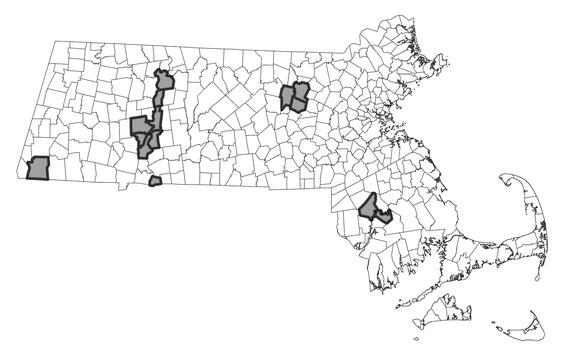- Scientific name: Carex typhina
- Species of Greatest Conservation Need (MA State Wildlife Action Plan)
- Threatened (MA Endangered Species Act)
Description
Cat-tail sedge, Carex typhina, is a grass-like perennial in the sedge family (Cyperaceae) that grows from 3-8 dm (1-2.75 ft) in height, in dense clumps. Its leaves are 5-10 mm (0.2-0.4 in) wide, with upper leaves generally overtopping the stem. Like most members of the sedge family, cat-tail sedge has no showy flower parts. The much-reduced flowers are arranged in 1-6 cylindrical spikes. The upper-most spikes are 2-4 cm (0.75-1.5 in) in length, consist mostly of pistillate (female) flowers and are subtended by a narrow bract (modified leaf located near a flower or inflorescence). The lateral spikes are somewhat smaller and entirely pistillate. Cat-tail sedge’s thin-walled perigynia (sac-like structures that surround the pistils and fruits) are 3.5-5 mm (0.14-0.2 in) long and obconic-obovoid in shape (roughly like an egg with its narrow end down). Each perigynium is topped with a two-toothed "beak" or elongation of the pistil. Obtuse to acute pistillate scales subtend each perigynium, but are generally hidden by the dense perigynia. The slender, uppermost portion of the pistil is straight or nearly straight.
Sedges, members of the genus Carex, are difficult to identify to species by all but the most expert since it is necessary to use technical characteristics to distinguish among the species. Keys to the genus should be used to identify the species.
Life cycle and behavior
Cat-tail sedge is a clonal, perennial species which produces scattered wind-pollinated spikes of flowers. Cat-tail sedge’s perigynia mature from early July through early September.
Population status
Cat-tail sedge is listed as threatened under the Massachusetts Endangered Species Act. There are thirteen populations that have been verified since 1999 and one which has not been observed recently.
Distribution and abundance
Cat-tail sedge is known from Quebec to Florida, west to Ontario and Texas. In New England, it is critically imperiled in Connecticut and Maine, imperiled in Massachusetts and Vermont and not known from New Hampshire and Rhode Island.

Distribution in Massachusetts
1999-2024
Based on records in the Natural Heritage Database
Habitat
Habitats of cat-tail sedge are floodplain forests and their immediate vicinity; all of which experience annual, spring flooding. Among the species associated with cat-tail sedge in Massachusetts are silver maple (Acer saccharinum), swamp white oak (Quercus bicolor), red maple (Acer rubrum), American elm (Ulmus americana), sensitive fern (Onoclea sensibilis), false nettle (Boehmeria cylindrica), and bladder sedge (Carex intumescens). Rare Massachusetts plants that have been found with cat-tail sedge include winged monkey-flower (Mimulus alatus) and Gray's sedge (Carex grayi).
Healthy habitats are vital for supporting native wildlife and plants. Explore habitats and learn about conservation and restoration in Massachusetts.
Threats
Competition from non-native invasive species can be a threat to cat-tail sedge, especially in disturbed habitats. Threats include changes in water quality and quantity and other degradation of habitat. All listed species are protected from killing, collecting, possessing, or sale and from activities that would destroy habitat and thus directly or indirectly cause mortality or disrupt critical behaviors.
Conservation
Monitoring and removal of competing vegetation should be considered as a management strategy where appropriate. All active management of rare plant populations—including invasive species removal—is subject to review under the Massachusetts Endangered Species Act and should be planned in close consultation with MassWildlife’s Natural Heritage & Endangered Species Program.
References
NatureServe. 2025. NatureServe Network Biodiversity Location Data accessed through NatureServe Explorer [web application]. NatureServe, Arlington, Virginia. Available https://explorer.natureserve.org/. Accessed: 5/22/2025.
USDA, NRCS. 2010. The PLANTS Database (http://plants.usda.gov, 6 December 2010). National Plant Data Center, Baton Rouge, LA 70874-4490 USA. http://plants.usda.gov/java/ profile?symbol=catY.
Contact
| Date published: | April 9, 2025 |
|---|